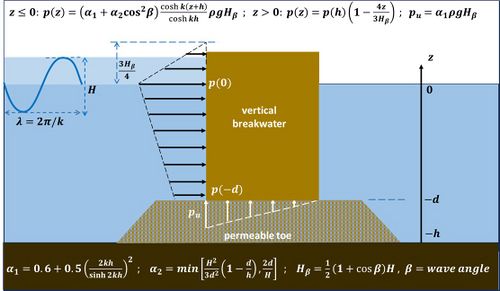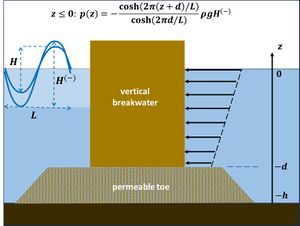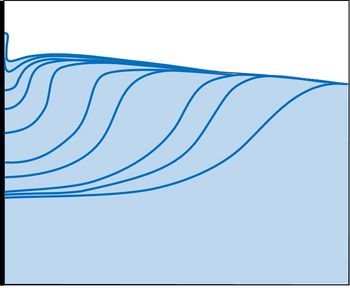Wave loading on coastal structures
Coastal structures, such as seawalls and breakwaters, are exposed to two types of wave impacts. On the one hand, the overall force exerted on the structure by the hydrostatic wave pressure and on the other hand, a local force generated by the wave impulse. The first type of impact does not strongly depend on the wave shape, see e.g. Shallow-water wave theory# Vertical Walls. The second impact type, in contrast, is much stronger for steep asymmetric waves than for sinusoidal waves. Gentle, regular waves are reflected at the structure creating a standing wave pattern, whereas steep waves can generate violent fluid motions and associated pressures when they collide with the structure. The structure of the wall (smooth, rough, perforated, block work, sloping or curved) also influences in this case the impact of a wave. The pressure-impulse impact is highly variable, as it strongly depends on the shape of the wave just before hitting the structure. The pressure peak is concentrated in a small area around the still water level. Since the impact is localized, it generally does not affect the structure stability as a whole, but it can cause important local damage.
Contents
Total wave pressure loading

The Goda wave load formula[1] predicts pulsating hydrostatic wave loads that must be taken into account to prevent failure mechanisms of caisson breakwaters due to sliding and overturning. They are the main forces to consider in the case of wind waves and swell of low to medium steepness reflecting off the vertical face of heavy monolithic structures. These heavy structures have a quasi-static response to wave loadings, since their characteristic natural periods are much shorter than the periods of the incident waves. Goda's original wave load formula for the design wave height [math]H[/math] (highest wave in the design sea state just in front of the structure, [math]\sim 1.8 \, H_s[/math]) is shown in Fig. 1. It considers the (slowly) pulsating loads of both breaking and reflected waves and includes the effect of the wave incidence angle [math]\beta[/math]. The wave pressure on the front face is denoted by [math]p(z)[/math] and the uplift pressure by [math]p_u[/math]. They are almost triangularly distributed along the structure's front face and bottom. The upward pressure is related to the movement of the pore fluid within the foundation. This pressure only occurs with permeable foundations, such as those made of rubble, and not with foundations of low permeability, such as stiff clay or fine, dense sand[2].
The maximum elevation to which pressure can be exerted is taken as [math]0.75 H[/math] above the still water level. Goda's formula has been refined later on by Takahashi et al. (1994[3]) and other authors. See also the Coastal Engineering Manual (2012[4]).

Under the wave trough, breakwaters are exposed to seaward wave loading. Small-scale field experiments by Botocci (2000[5]) have shown that this seaward wave loading can be very strong and can even exceed the maximum landward wave loading. The seaward pressure distribution and the associated formula are shown in Figure 2. For a design sea state with a given significant wave height [math]H_s[/math] just in front of the structure, the wave height [math]H^{(-)}[/math] corresponds to the deepest wave troughs statistically occurring with a certain low frequency. Boccotti et al. (2012[6]) determined these virtual wave heights [math]H^{(-)}[/math] empirically for intermediate water depths ([math]d/L \sim 0.15-0.2[/math]) with the result: [math]H^{(-)} \approx 1.5 \, H_s[/math] for the average of the 10% deepest wave troughs, [math]H^{(-)} \approx 2 \, H_s[/math] for the 1% deepest troughs and [math]H^{(-)} \approx 2.3 \, H_s[/math] for the 1‰ deepest troughs. The weight of negative pressures becomes more important as water depth increases. For [math]d/L \sim 0.2-0.3[/math] the 1‰ deepest troughs correspond to [math]H^{(-)} \approx 3 \, H_s[/math]. This implies that the control of the overall stability under the action of negative wave forces becomes crucial in deep water ([math]d/L \gt 0.2[/math]).
Wave-impulse loading
A wave impulse is the momentum transferred from the advancing wave front to the structure. If the front of the incident wave steepens and becomes more or less vertical just before it reaches the vertical wall of a structure, the wave impulse impact can be very violent. The peak pressure is inversely related to the impact area and impact duration. Impact durations are of the order of 10 to 100 milliseconds and peak pressures can reach up to 1 MPa[7]. The impact process is closely linked to the shape of the breaking wave in front of the structure. The greatest water speed generated by a freely traveling water wave occurs when the crest of the wave overturns, generating a jet of water as the wave breaks. This jet of water traps an air pocket as it strikes the wall. A fraction of the compressed air pocket is released upwards with the wave splash while the remainder is collapsed into small air bubbles[8], see also Wave collision on a vertical wall. Breakaway of the air pocket results in a strong reduction of the peak pressure magnitude and generates a double-peaked pressure just below the impinging region. If the wave has already fully broken before the impact, the turbulent wave front consists of an air-water mixture when hitting the wall[9]. The compressibility of the air increases the impact duration and so reduces the pressure impact. The cushion effect increases with the size of the entrapped air pocket, but very high peak pressures have been recorded for both small and large air pockets [7]. Localized high-pressure events can also be disrupted by disturbances, for example if the structure has roughness elements that are small on the scale of the incident wave but have a size comparable to that of the peak pressure area[9]. Based on large-scale flume tests, Cuomo et al. (2010[10]) propose the following empirical formula for the impact force [math]F_{1/250}[/math] exerted by the mean of the 1/250 highest waves on a vertical structure,
[math]F_{1/250} = C_r^{1.65} \, \rho \, g \, H \, L \, \Big(1 - \dfrac{|h_b-h|}{h} \Big) \, . [/math]
Meaning of the symbols: [math]C_r=[/math] wave reflection coefficient of the structure (about 0.9 for vertical walls), [math]\rho=[/math] seawater density, [math]g=[/math] gravitational acceleration, [math]H=[/math] significant (spectral) wave height, [math]L=[/math] wavelength, [math]h=[/math] water depth at the toe of the structure, [math]h_b=[/math] breaker depth.
Flip-through wave impact

Flume experiments show that the steep front of a wave that propagates towards a solid wall will not always crash onto the wall as in the wave-impulse scenario. Instead, the wave trough ahead of the advancing wave crest is compressed against the wall and fills quickly as the wave front gets close. The water level in the wave trough rises so rapidly that a small jet is formed that climbs the wall in a split second before the wave front reaches the wall. This phenomenon, illustrated in Fig. 3, is called flip-through. The fast, vertical jet that emerges from a small high pressure region near the wall, implies that the violent flip-through occurs without any actual impact. Although the jet prevents the wave front from making direct contact with the wall, computations demonstrate that the resultant smooth flow can still generate very large localized pressures on the wall[9].
The flip-through phenomenon may occur at any rigid boundary over which the free surface moves because gravity is unimportant in this part of the flow, so the 'wall' need not be vertical. For example, flip-through does appear when waves hit a beach of moderate slope without breaking and produce a uprush jet[9].
Related articles
- Wave collision on a vertical wall
- Stability of rubble mound breakwaters and shore revetments
- Shallow-water wave theory
- Statistical description of wave parameters
References
- ↑ 1.0 1.1 Goda, Y. 1974. A new method of wave pressure calculation for the design of composite breakwater. In Proceedings of the 14th Conference on Coastal Engineering. ASCE, pp. 1702–1720
- ↑ Davies, M.H. 1996. Seabed and Foundation Response to Wave Loading. Procs. Coastal Engineering Conf. 1996, ASCE
- ↑ Takahashi, S., Tanimoto, K. and Shimosako, K. 1994. A Proposal of Impulsive Pressure Coefficient for the Design of Composite Breakwaters. In Hydro-port’94, Proceedings of the International Conference on Hydro-Technical Engineering for Port and Harbor Construction. Port and Harbour Research Institute, pp. 489–504
- ↑ USACE 2012. Coastal Engineering Manual Vol. VI-5, pp. 145-173
- ↑ 5.0 5.1 Boccotti, P. 2000. Wave mechanics for ocean engineering, Elsevier Science, Oxford, UK
- ↑ Boccotti, P., Arena, F., Fiamma, V., Romolo, A. and Barbaro, G. 2012. Small-Scale Field Experiment on Wave Forces on Upright Breakwaters. J. Waterw. Port Coast. Ocean Eng. ASCE 138: 97–114
- ↑ 7.0 7.1 Bullock, G.N. and Bredmose, H. 2024. Violent breaking-wave impacts. Part 4: A detailed analysis and comparison of field and 1:4 scale measurements on sloping and vertical walls including the influence of air and scale effects. Coastal Engineering 191, 104520
- ↑ Hattori, M., Arami, A. and Yui,T. 1994. Wave impact pressure on vertical walls under breaking waves of various types. Coast. Eng. 22: 79–114
- ↑ 9.0 9.1 9.2 9.3 9.4 Peregrine, D. 2003. Water-wave impact on walls. Annual review of fluid mechanics 35: 23–43
- ↑ Cuomo, G., Allsop, W., Bruce, T. and Pearson, J. 2010. Breaking wave loads at vertical seawalls and breakwaters. Coastal Engineering 57: 424-439
Please note that others may also have edited the contents of this article.
|